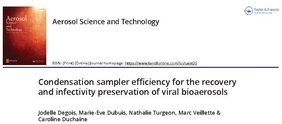Article important dans le journal Aerosol Science and Technology
Voici le résumé en anglais pour celles et ceux qui seraient intéressés:
A better description of airborne transmission routes of viruses that are responsible for nosocomial infections requires efficient and accurate sampling methods that allow the preservation of viral integrity and infectivity. The aim of this project was to compare the virus collection efficiency of traditional filter sampling using cassettes with water-based condensation sampling through laminar flow. Bacteriophages MS2, PhiX174, Phi6, and PR772 as well as an influenza virus were nebulized in an aerosol chamber. Bioaerosols were simultaneously collected on polycarbonate (PC) filters (0.8 μm pore diameter) loaded into 37-mm closed-face cassettes (CFCs) and with a condensation-based sampler (Spot Sampler™) which collected bioaerosols in a liquid buffer. Concentrations of bacteriophages and influenza were analyzed at two different sampling times (60 min and 4 h) both by culture (infectivity preservation) and qPCR (efficiency of recovery) to compare the performance of the two samplers. PhiX174 showed better recovery with the Spot Sampler™ for both sampling times and PR 772 showed better relative genome recovery with CFC sampling after 60 min. In addition, use of the Spot Sampler™ led to better preservation of infectivity for all the viruses including influenza, with the exception of phage MS2 after 4 h of sampling. In future work, the Spot Sampler™ could be tested in hospital environments to better understand airborne transmission routes of viruses, or in in-vitro setups to assess the efficiency of virucidal air treatment.

